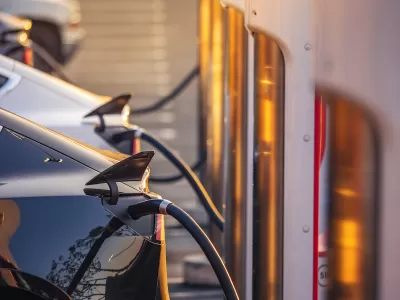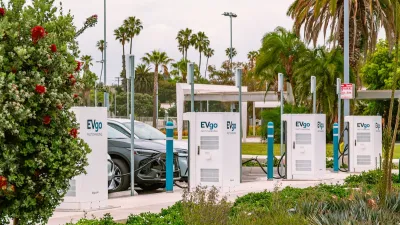Local zoning codes can be adjusted to encourage the building of EV charging infrastructure into neighborhoods.

In an article for the New York Law Review, Anthony S. Guardino outlines the zoning and regulatory challenges faced by municipalities hoping to shift to electrified vehicle infrastructure.
“In order to facilitate and encourage more EV charging stations, municipalities need to update their zoning ordinances to regulate and manage this new land use. Zoning code amendments should provide developers and property owners with clear guidance on the manner in which applications for charging stations will be processed and the timing of approvals, so that the process is more predictable.”
The article suggests that cities can include EV charging requirements in building codes, pass ordinances that facilitate charging facilities in neighborhoods, and streamline approval processes for EV charging stations. “Some New York municipalities have updated their zoning ordinances to address the above questions by designating EV charging stations to be permitted principal uses in commercial and industrial districts, or by allowing EV charging to be located in all zoning districts as permitted accessory uses.”
The article concludes that, as EV adoption grows, cities should proactively update their zoning codes to account for electric vehicle infrastructure.
FULL STORY: Thorny Zoning Questions Posed by EV Charging Stations

Study: Maui’s Plan to Convert Vacation Rentals to Long-Term Housing Could Cause Nearly $1 Billion Economic Loss
The plan would reduce visitor accommodation by 25,% resulting in 1,900 jobs lost.

North Texas Transit Leaders Tout Benefits of TOD for Growing Region
At a summit focused on transit-oriented development, policymakers discussed how North Texas’ expanded light rail system can serve as a tool for economic growth.

Why Should We Subsidize Public Transportation?
Many public transit agencies face financial stress due to rising costs, declining fare revenue, and declining subsidies. Transit advocates must provide a strong business case for increasing public transit funding.

How to Make US Trains Faster
Changes to boarding platforms and a switch to electric trains could improve U.S. passenger rail service without the added cost of high-speed rail.

Columbia’s Revitalized ‘Loop’ Is a Hub for Local Entrepreneurs
A focus on small businesses is helping a commercial corridor in Columbia, Missouri thrive.

Invasive Insect Threatens Minnesota’s Ash Forests
The Emerald Ash Borer is a rapidly spreading invasive pest threatening Minnesota’s ash trees, and homeowners are encouraged to plant diverse replacement species, avoid moving ash firewood, and monitor for signs of infestation.
Urban Design for Planners 1: Software Tools
This six-course series explores essential urban design concepts using open source software and equips planners with the tools they need to participate fully in the urban design process.
Planning for Universal Design
Learn the tools for implementing Universal Design in planning regulations.
Ascent Environmental
Borough of Carlisle
Institute for Housing and Urban Development Studies (IHS)
City of Grandview
Harvard GSD Executive Education
Toledo-Lucas County Plan Commissions
Salt Lake City
NYU Wagner Graduate School of Public Service





























